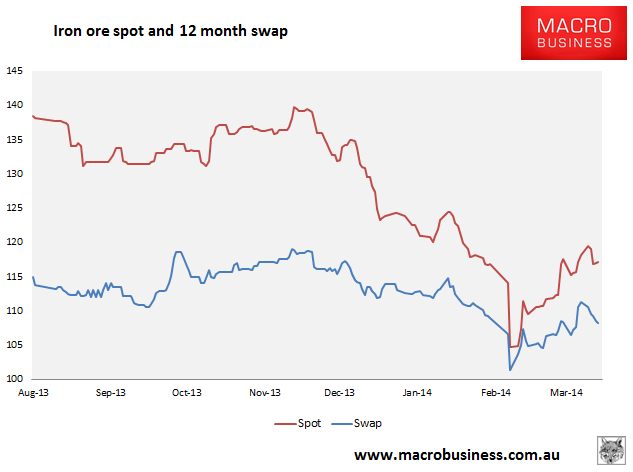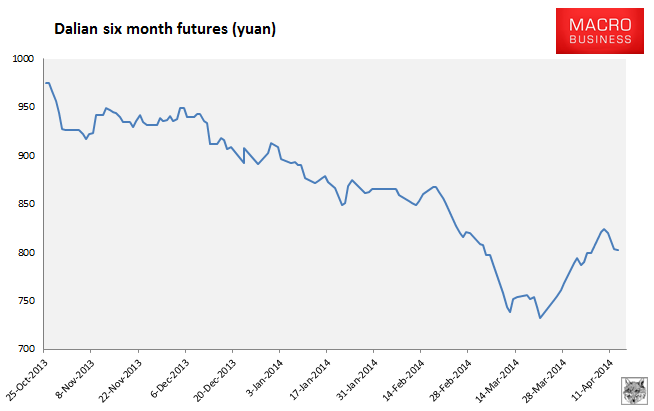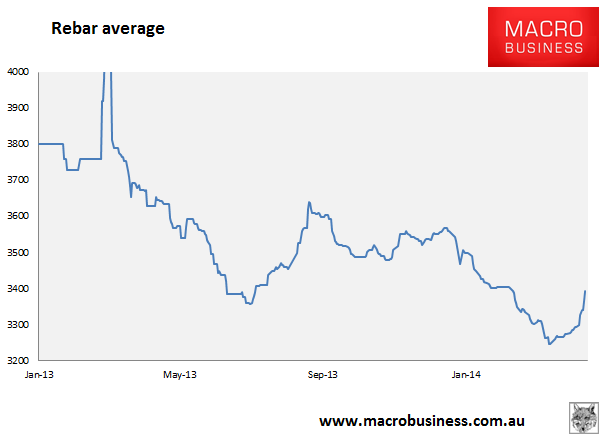Here are the iron ore price charts for April 15, 2014:




Paper markets continued their stall with rebar futures flat. Physical is becalmed too and the Baltic Dry capesize component fell another 2%. Rebar offers hope jumping again but there is some weirdness in my data so that may have been the day before and yesterday flattish.
Reuters has texture:
“The general market sentiment remains weak amid gloomy expectations for first-quarter economic growth, which keeps denting steel demand and prices,” said Xia Junyan, an analyst with Wanda Futures in Shanghai.
“I don’t expect any big improvement in steel prices in the near future.”
…China’s major steel companies lost 4.7 billion yuan ($755.74 million) in the first two months of the year, compared with a profit of 5.1 billion yuan in the same period last year, local media reported on Monday, citing data from the China Iron & Steel Association.
Shrinking profit margins and falling steel prices are forcing Chinese steelmakers, which produce about half of the world’s steel output, to curb purchases of iron ore.
“The market has been quiet since Monday afternoon, and everyone is watching closely for the upcoming economic data in order to find clues for the market trend,” said an iron ore trader in Beijing.
“Demand is still there, but steel mills are bargaining a lot and offering very low prices for cargoes.”
Sounds right. Meanwhile, Rio is bearing-up nicely, from The Australian:
Fronting the big miner’s annual general meeting in London overnight, chairman Jan du Plessis warned the miner was still operating in a challenging and volatile environment.
“While the outlook is now brighter (than last year) in some parts of the world, we believe that volatility looks set to remain in the short to medium term as a number of structural deficiencies remain unresolved,” Mr du Plessis said.
The comments are a marked pullback from February, when Rio released its most buoyant economic outlook in years.
..“Tensions remain in Europe, and the pace of reform and structural readjustments is slow,” he said. “The combination of low interest rates, low growth and low inflation leaves that continent with considerable challenges. In the US the unwinding of quantitative easing represents uncharted territory.”
China could also provide uncertainty, he said.
“While the fundamental drivers of the Chinese economy remain intact, we can expect some variability in the near term as authorities endeavour to steer the economy along a more sustainable and steady path of growth,” he said.
“There is no question, however that the Chinese leadership remains committed to pursuing economic reform, which offers potential benefits for the global economy in the long term, even if there is some variability along the way.”
Correct. But Mr du Plessis might want to brush up on his economics. Commitment to reform in China means one thing above all else: less building and less steel.

